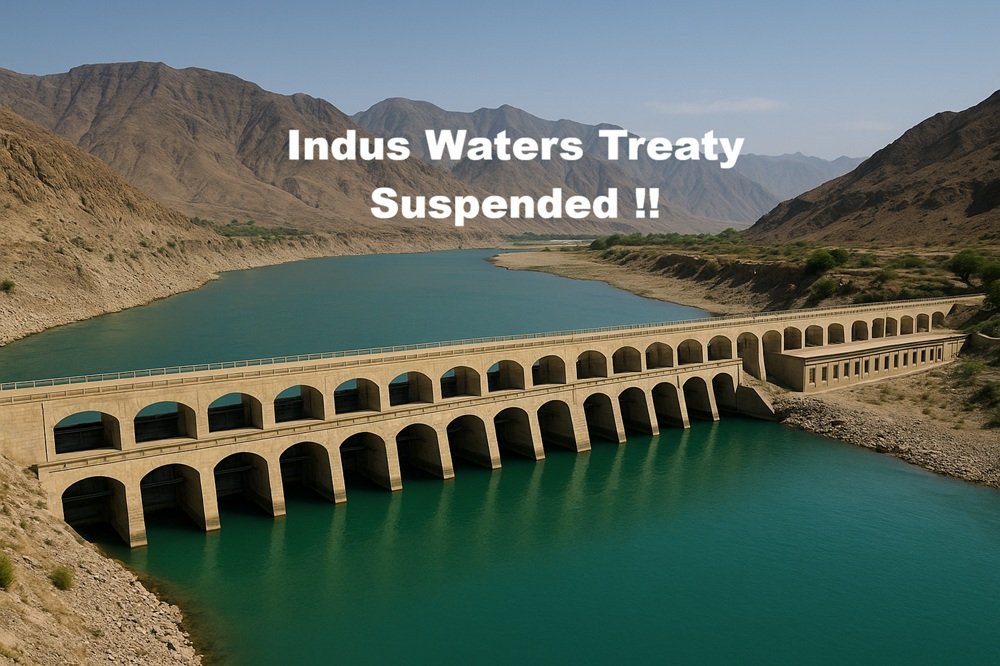
Latest Development: Treaty Suspended After Pahalgam Terror Attack (April 2025)
➤ Date of Suspension: April 23, 2025
➤ Cause: Terrorist attack in Pahalgam, Jammu & Kashmir
- Attack killed 26 Indian citizens including civilians and security personnel.
- Intelligence sources traced the plot to Pakistan-based terror outfit Lashkar-e-Taiba.
Read this: India’s 5 Big Steps Against Pakistan, Day After Pahalgam Terror Attack
➤ Actions Taken by India:
- Suspension of the Indus Waters Treaty citing Pakistan’s continued support for terrorism.
- Cabinet Committee on Security (CCS), chaired by PM Modi, decided to:
- Block design approvals of any new Pakistan projects under IWT.
- Accelerate hydroelectric project construction on western rivers.
- Explore full utilization of India’s share under the treaty.
What Does This Mean for the Future?
➤ If India Fully Revokes the Treaty:
- Could trigger a major diplomatic conflict, possibly even war, given Pakistan’s heavy dependence on the Indus basin.
- Could lead to international arbitration and intervention.
➤ If India Strategically Utilizes Its Rights:
- Can build storage, dams, and barrages within the treaty limits.
- May effectively reduce water availability downstream during lean seasons, applying pressure without violating treaty clauses.
Indus Waters Treaty Overview
The Indus Waters Treaty (IWT) is a historic water-sharing agreement signed between India and Pakistan in 1960, brokered by the World Bank. Often hailed as one of the most successful transboundary water treaties in history, the IWT has endured despite multiple wars and longstanding tensions between the two countries. However, in recent years—especially after terror attacks and escalating diplomatic hostility—India has increasingly questioned the fairness and relevance of the treaty.
As of April 2025, India has suspended the Indus Waters Treaty, following the Pahalgam terror attack that claimed 26 lives, allegedly planned and executed by Pakistan-based militants. This move marks the most significant development in the history of the IWT.
This article provides an in-depth look at the treaty’s origin, structure, benefits, disputes, and the implications of its suspension.
Historical Background
➤ Partition and the Problem of Rivers
At the time of India’s independence and partition in 1947, the Indus river system became a contentious issue. Though the rivers originated in India, they flowed predominantly into Pakistan. This led to fears in Pakistan that India could potentially choke off its water supply.
➤ Temporary Agreement: The Standstill Agreement (1947–1951)
After partition, a Standstill Agreement was signed to maintain the status quo until a permanent arrangement could be worked out. However, in 1948, India stopped the water flow from the Ferozepur headworks into Pakistan for a short period, prompting panic and urgent negotiations.
Signing of the Treaty (1960)
- Date: September 19, 1960
- Signatories:
- India: Prime Minister Jawaharlal Nehru
- Pakistan: President Ayub Khan
- Broker: The World Bank
Key Objective:
To fairly divide the waters of the six rivers of the Indus basin between India and Pakistan to ensure long-term cooperation and avoid future conflicts.
Provisions of the Indus Waters Treaty
➤ Division of Rivers:
The six rivers of the Indus basin were divided as follows:
Pakistan Gets Full Rights Over:
- Indus
- Jhelum
- Chenab
India Gets Full Rights Over:
- Ravi
- Beas
- Sutlej
India is allowed non-consumptive use (like hydroelectricity) of the western rivers (Indus, Jhelum, Chenab), without altering flow volumes to Pakistan.
➤ Institutional Mechanism:
- Permanent Indus Commission (PIC): A bilateral commission to resolve disputes and share technical data.
- Annual meetings and exchange of data on river flows and projects.
➤ Dispute Resolution Mechanism:
- Questions are handled by the Permanent Indus Commission.
- Disputes go to a Neutral Expert appointed by the World Bank.
- Serious disputes are adjudicated at the Court of Arbitration.
Why Has the Treaty Been So Resilient?
- Neutrality of Water: Both nations recognize the humanitarian and ecological need for uninterrupted water flow.
- Legal and Diplomatic Structure: Strong dispute resolution mechanisms.
- World Bank Involvement: Adds legitimacy and third-party oversight.
- Interdependence: Despite tensions, Pakistan is heavily reliant on Indian-controlled rivers.
Challenges and Disputes
1. India’s Hydroelectric Projects
Pakistan has repeatedly objected to Indian hydroelectric projects on the western rivers:
- Baglihar Dam on the Chenab River (dispute resolved by a Neutral Expert)
- Kishanganga Project on the Jhelum River (settled by the Court of Arbitration)
2. Climate Change
Shrinking glaciers, erratic monsoons, and rising temperatures threaten the flow of Himalayan rivers, potentially aggravating future disputes.
3. Strategic Leverage
Some Indian policymakers argue that the IWT provides undue strategic advantage to Pakistan, allowing it access to 80% of Indus basin water while continuing hostile acts against India.
Conclusion: A Treaty Hanging by a Thread
The Indus Waters Treaty has been a symbol of cooperation amid conflict for over six decades. However, the changing geopolitical climate, repeated terror strikes, and growing nationalism are pushing it to the brink. As of April 2025, the suspension of the treaty by India is unprecedented and sets the stage for a possible reconfiguration of South Asia’s water geopolitics.
The world watches closely as two nuclear-armed nations navigate this dangerous new phase. Whether this leads to renegotiation, escalation, or reconciliation remains to be seen.







